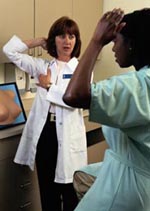Breast Health: Three-Step Plan for Preventive Care

The thought of having breast cancer is frightening to everyone, and especially devastating to women. However, ignoring the possibility that you may develop breast cancer or avoiding the processes to detect cancer can be dangerous.
Although there are some women who are at higher risk, the fact is that all women are at risk for breast cancer. That's why it's so important to follow this three-step plan for preventive care. Although breast cancer can't be prevented at the present time, early detection of problems provides the greatest possibility of successful treatment.
What is the three-step plan?
Routine care is the best way to keep you and your breasts healthy. Although detecting breast cancer at its earliest stages is the main goal of routine breast care, other benign conditions, such as fibrocystic breasts, are often discovered through routine care.
|
Step 1. Breast self-examination (BSE)
|
|
The American Cancer Society (ACS) says that breast self-exams are an option for women ages 20 and older as a means of familiarizing themselves with their breasts so they can notice changes more easily. BSE should be done regularly at the same time every month. Regular BSE teaches you to know how your breasts normally feel so that you can more readily detect any change. Changes may include:
-
Development of a lump
-
A discharge other than breast milk
-
Swelling of the breast
-
Skin irritation or dimpling
-
Nipple abnormalities (for example, pain, redness, scaliness, or turning inward)
If you notice any of these changes, see your health care provider as soon as possible for evaluation.
The U.S. Preventive Services Task Force (USPSTF) doesn't recommend breast self-exams (BSEs) because evidence suggests BSEs do not lower risk for death from breast cancer. Talking with your doctor about the benefits and limitations can help you decide if you should start performing BSEs.
|
|
Step 2. Clinical examination
|
|
A breast examination by a doctor or nurse trained to evaluate breast problems should be part of a woman's physical examination. The ACS recommends:
-
Between ages 20 and 39, women should have a clinical breast examination (CBE) by a health professional every three years.
-
After age 40, women should have a breast examination by a health professional every year.
The USPSTF, however, believes there isn't enough evidence to assess the value of CBEs for women ages 40 and older. Women should talk with their doctors or other health care providers about their personal risk factors and make a decision about whether they should have a CBE.
A clinical breast examination by a doctor or nurse is very similar to the procedures used for breast self-examination. Women who routinely practice BSE will be prepared to ask questions and have their concerns addressed during this time.
|
|
Step 3. Mammography
|
|
Mammography is a low-dose X-ray of the breasts to find changes that may occur. It's the most common imaging technique. Mammography can detect cancer or other problems before a lump becomes large enough to be felt, as well as assist in the diagnosis of other breast problems. However, a biopsy is required to confirm the presence of cancer.
Experts have different recommendations for mammography. Currently, the USPSTF recommends screening every two years for women between ages 50 and 74. The ACS recommends yearly screening for all women ages 40 and older. Women should talk with their doctors or other health care providers about their personal risk factors before making a decision about when to start getting mammograms or how often they should get them.
A diagnostic mammogram may be required when a questionable area is found during a screening mammogram.
Both the National Cancer Institute and the ACS suggest that women who may be at increased risk for breast cancer should talk with their doctors or other health care providers about whether to begin having mammograms at an earlier age.
|
Schedule a Mamogram at Richmond University Medical Center
Early detection and treatment is the best strategy for a better cancer outcome. Schedule your mamogram at RUMC: Call 718-818-3280.
Kathy Giovinazzo is Director of Radiology at Richmond University Medical Center.
For More Information
For more information or to schedule an appointment, contact Dr. Thomas Forlenza at 718-816-4949. His office is located at 1366 Victory Blvd on Staten Island.
Dr. Forlenza is the Director of Oncology at Richomd University Medical Center
© 2000-2025 The StayWell Company, LLC. All rights reserved. This information is not intended as a substitute for professional medical care. Always follow your healthcare professional's instructions.